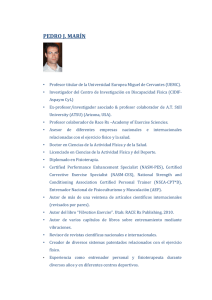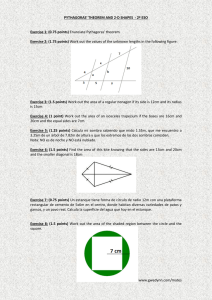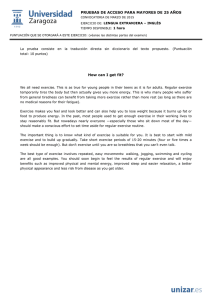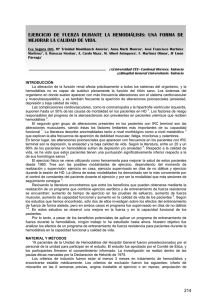Physiotherapy during hemodialysis: results of a progressive
Anuncio
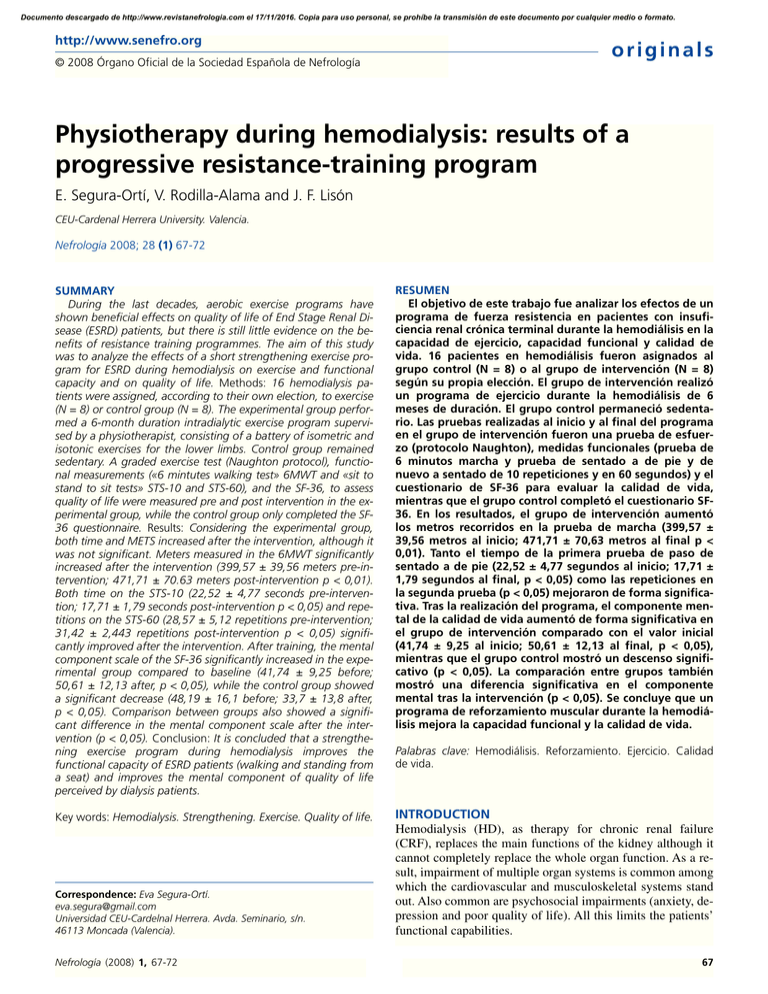
Documento descargado de http://www.revistanefrologia.com el 17/11/2016. Copia para uso personal, se prohíbe la transmisión de este documento por cualquier medio o formato. http://www.senefro.org © 2008 Órgano Oficial de la Sociedad Española de Nefrología originals Physiotherapy during hemodialysis: results of a progressive resistance-training program E. Segura-Ortí, V. Rodilla-Alama and J. F. Lisón CEU-Cardenal Herrera University. Valencia. Nefrología 2008; 28 (1) 67-72 SUMMARY During the last decades, aerobic exercise programs have shown beneficial effects on quality of life of End Stage Renal Disease (ESRD) patients, but there is still little evidence on the benefits of resistance training programmes. The aim of this study was to analyze the effects of a short strengthening exercise program for ESRD during hemodialysis on exercise and functional capacity and on quality of life. Methods: 16 hemodialysis patients were assigned, according to their own election, to exercise (N = 8) or control group (N = 8). The experimental group performed a 6-month duration intradialytic exercise program supervised by a physiotherapist, consisting of a battery of isometric and isotonic exercises for the lower limbs. Control group remained sedentary. A graded exercise test (Naughton protocol), functional measurements («6 mintutes walking test» 6MWT and «sit to stand to sit tests» STS-10 and STS-60), and the SF-36, to assess quality of life were measured pre and post intervention in the experimental group, while the control group only completed the SF36 questionnaire. Results: Considering the experimental group, both time and METS increased after the intervention, although it was not significant. Meters measured in the 6MWT significantly increased after the intervention (399,57 ± 39,56 meters pre-intervention; 471,71 ± 70.63 meters post-intervention p < 0,01). Both time on the STS-10 (22,52 ± 4,77 seconds pre-intervention; 17,71 ± 1,79 seconds post-intervention p < 0,05) and repetitions on the STS-60 (28,57 ± 5,12 repetitions pre-intervention; 31,42 ± 2,443 repetitions post-intervention p < 0,05) significantly improved after the intervention. After training, the mental component scale of the SF-36 significantly increased in the experimental group compared to baseline (41,74 ± 9,25 before; 50,61 ± 12,13 after, p < 0,05), while the control group showed a significant decrease (48,19 ± 16,1 before; 33,7 ± 13,8 after, p < 0,05). Comparison between groups also showed a significant difference in the mental component scale after the intervention (p < 0,05). Conclusion: It is concluded that a strengthening exercise program during hemodialysis improves the functional capacity of ESRD patients (walking and standing from a seat) and improves the mental component of quality of life perceived by dialysis patients. RESUMEN El objetivo de este trabajo fue analizar los efectos de un programa de fuerza resistencia en pacientes con insuficiencia renal crónica terminal durante la hemodiálisis en la capacidad de ejercicio, capacidad funcional y calidad de vida. 16 pacientes en hemodiálisis fueron asignados al grupo control (N = 8) o al grupo de intervención (N = 8) según su propia elección. El grupo de intervención realizó un programa de ejercicio durante la hemodiálisis de 6 meses de duración. El grupo control permaneció sedentario. Las pruebas realizadas al inicio y al final del programa en el grupo de intervención fueron una prueba de esfuerzo (protocolo Naughton), medidas funcionales (prueba de 6 minutos marcha y prueba de sentado a de pie y de nuevo a sentado de 10 repeticiones y en 60 segundos) y el cuestionario de SF-36 para evaluar la calidad de vida, mientras que el grupo control completó el cuestionario SF36. En los resultados, el grupo de intervención aumentó los metros recorridos en la prueba de marcha (399,57 ± 39,56 metros al inicio; 471,71 ± 70,63 metros al final p < 0,01). Tanto el tiempo de la primera prueba de paso de sentado a de pie (22,52 ± 4,77 segundos al inicio; 17,71 ± 1,79 segundos al final, p < 0,05) como las repeticiones en la segunda prueba (p < 0,05) mejoraron de forma significativa. Tras la realización del programa, el componente mental de la calidad de vida aumentó de forma significativa en el grupo de intervención comparado con el valor inicial (41,74 ± 9,25 al inicio; 50,61 ± 12,13 al final, p < 0,05), mientras que el grupo control mostró un descenso significativo (p < 0,05). La comparación entre grupos también mostró una diferencia significativa en el componente mental tras la intervención (p < 0,05). Se concluye que un programa de reforzamiento muscular durante la hemodiálisis mejora la capacidad funcional y la calidad de vida. Key words: Hemodialysis. Strengthening. Exercise. Quality of life. INTRODUCTION Hemodialysis (HD), as therapy for chronic renal failure (CRF), replaces the main functions of the kidney although it cannot completely replace the whole organ function. As a result, impairment of multiple organ systems is common among which the cardiovascular and musculoskeletal systems stand out. Also common are psychosocial impairments (anxiety, depression and poor quality of life). All this limits the patients’ functional capabilities. Correspondence: Eva Segura-Ortí. [email protected] Universidad CEU-Cardelnal Herrera. Avda. Seminario, s/n. 46113 Moncada (Valencia). Nefrología (2008) 1, 67-72 Palabras clave: Hemodiálisis. Reforzamiento. Ejercicio. Calidad de vida. 67
